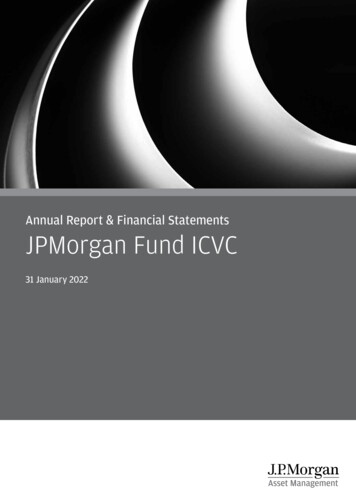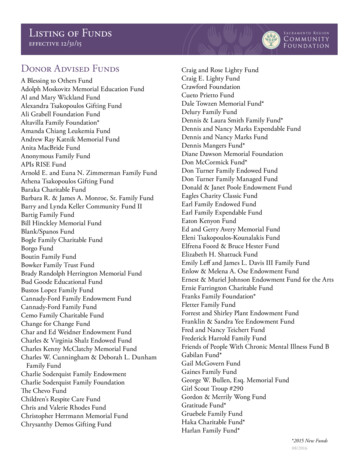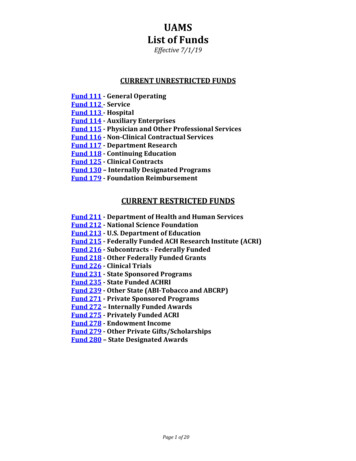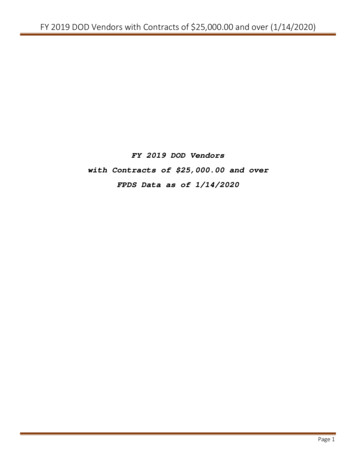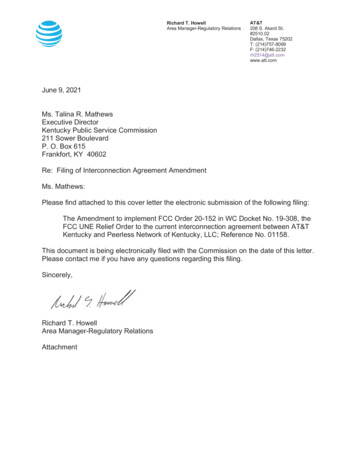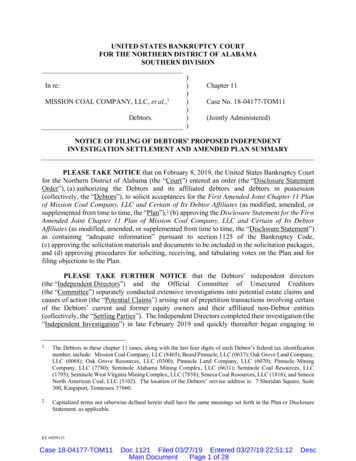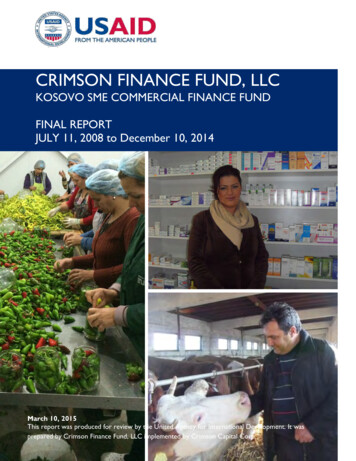
Transcription
CRIMSON FINANCE FUND, LLCKOSOVO SME COMMERCIAL FINANCE FUNDFINAL REPORTJULY 11, 2008 to December 10, 2014March 10, 2015This reportMay 31,was2014produced for review by the United Agency for International Development. It wasprepared by Crimson Finance Fund, LLC implemented by Crimson Capital Corp.This publication was produced for review by the United States Agency for International Development. Itwas prepared by AECOM International Development.
CRIMSON FINANCE FUND, LLCKOSOVO SME COMMERCIAL FINANCE FUND (CFF)FINAL REPORTJuly 11, 2008 to December 10, 2014Prepared by:Crimson Finance Fund, LLCImplemented by Crimson Capital Corp.Award No.:Cooperative Agreement #167-00-08-00101-00Agreement Officer’s Representative:Chairman:Dardane PejaMichael GoldThe Crimson Finance Fund is supported by:DISCLAIMERThe author’s views expressed in this publication do not necessarily reflect the views of theUnited States Agency for International Development or the United States Government.
ACRONYMSCFFCrimson Finance Fund, LLCCBKCentral Bank of the Republic of KosovoIFCInternational Finance Corporation/World Bank GroupIFRSInternational Financial Reporting StandardsIMFInternational Monetary FundKBRAKosovo Business Registration AgencyME&AMendez, England & AssociatesMFIMicrofinance InstitutionNBFINon-Bank Financial InstitutionNMFANorwegian Ministry of Foreign AffairsNORFUNDNorwegian Investment Fund for Developing CountriesNPLNon-performing LoanPEAPrivate Enforcement AgentsPOFPurchase Order FinancePPPPublic Private PartnershipSMESmall and Medium Sized EnterpriseTAKTax Authority of KosovoUSAIDUnited Stated Agency for International DevelopmentUSAID CLEUSAID Contract Law Enforcement Project
CONTENTSI. EXECUTIVE SUMMARY .1Project Background .1Accomplishments and Results .3Conclusions .3II. ACTIVITIES AND RESULTS .5Year 1: July 2008 – June 2009 . 10Year 2: July 2009 – June 2010 . 11Year 3: July 2010 – June 2011 . 13Year 4: July 2011 – June 2012 . 15Year 5: July 2012 – June 2013 . 17Year 6: July 2013 – December 2014 . 20III. FINDINGS & RECOMMENDATIONS . 24ANNEX 1: SUCCESS STORIES . 26ANNEX 2: ANNUAL PERFORMANCE MATRIX . 38ANNEX 3: ANNUAL NON-PERFORMING LOANS – CFF AND BANKS. 40ANNEX 4: LIST OF LOANS TO CFF CLIENTS . 41ANNEX 5: LOANS AND LOAN VALUE BY SECTOR . 71ANNEX 6: ENVIRONMENTAL COMPLIANCE . 72ANNEX 7: GENDER EQUALITY ACTIVITIES . 77ANNEX 8: LOANS/LEASES IN THE MUNICIPALITIES – MUNICIPAL FACTSHEETS . 80
I. EXECUTIVE SUMMARYProject BackgroundIn Kosovo, as in most emerging market economies, small and medium sized enterprises (SMEs)have difficulty obtaining the funds they need from banks to fill orders for their products andservices, increase local production and sales, improve quality and competitiveness, and hiremore people. This is especially true for entrepreneurs, innovators, farmers, woman-ownedbusinesses and minority-owned businesses. The Crimson Finance Fund, LLC (CFF) wasestablished in 2008 to address this need for improved access to finance. CFF is designed toprovide working capital and equipment finance to underserved Kosovo SMEs, using innovativefinancial products such as Purchase Order Finance, (POF) and equipment leasing. CFF’s missionis to enable businesses to grow, become more competitive, provide import substitution,increase exports, and create new jobs.CFF is implemented by Crimson Capital Corp. (Crimson). Crimson developed CFF’s structure,corporate governance, staffing, operations, business plan and license application to the CentralBank of Kosovo (CBK) under two grants from the Norwegian Ministry of Foreign Affairs(NMFA) totaling 346,000 EUR, which were awarded in late 2006 and 2007. CFF is modeledafter the successful Macedonia SME Commercial Finance Fund, also implemented by Crimson(which was started under a Cooperative Agreement with USAID and subsequently was alsosupported by Norfund).Crimson chose the limited liability company (LLC) structure as optimal for CFF in Kosovo, andregistered it with the Kosovo Business Registration Agency (KBRA) and the Tax Authority ofKosovo (TAK). The CBK licensed CFF as a non-bank financial institution (NBFI) on June 28,2008. CFF is supervised by the CBK and operates under the regulations and policies for NBFIsin Kosovo.Through a Cooperative Agreement, #167-A-00-08-00101-00, USAID originally awarded 700,000 for lending capital to CFF, which was disbursed to CFF on October 29, 2008. CFFwas able to disburse its first loan in December 2008. On September 20, 2010, USAID providedan additional 1.5 million for agricultural finance and the project end date was extended toDecember 10, 2014. All USAID funds have been used exclusively for lending to SMEs, never tocover any expenses. On October 28, 2014, USAID approved the Disposition Plan for this loancapital of 2.2 million, allowing the funds to remain with CFF for an additional five years andthree months through March 10, 2020 for continued lending to Kosovo SMEs.On July 29, 2008, CFF entered into a loan agreement with the Norwegian Investment Fund forDeveloping Countries (Norfund) for a loan of 800,000 EUR (approximately 1.2 million) for onlending to SMEs. These funds were disbursed in two tranches to CFF: 100,000 EUR in March2009 and 700,000 EUR in June 2009. On December 1, 2011, CFF entered into another loanagreement with Norfund for an additional 800,000 EUR. Like the USAID funds, the Norfundmoney is exclusively for on-lending to SMEs.On July 7, 2012, the NMFA awarded a permanent grant in perpetuity of 1 million to CFF for1
on-lending to SMEs in Northern Kosovo.Crimson had a total cost share requirement under the USAID Cooperative Agreement of 551,000. As of December 2014, Crimson contributed 232,829 in equity and 378,641 inadditional cost share, for a total of 611,470.The initial design concept and goals for CFF were extremely ambitious: using modest seedmoney to cover operational and administrative expenses for its initial start-up phase, CFF wasto become completely self-financing and self-sustaining from interest and fee income on theloans in just two years. The bulk of CFF’s funding was earmarked exclusively for on-lending toSME clients; these funds were to be lent, repaid and relent, continuously multiplying SMEgrowth, sales and job creation results. All operational costs, including personnel, benefits, officespace, utilities, travel, telecommunications, supplies, etc., were to be covered by interest andfee income from disbursed loans.“Even though we had the capacity toCFF was also designed to fill a critical niche of financing quickly repay a loan, banks turned usfor small and mid-sized businesses, not adequately away. CFF saw our potential andserved by the MFIs and banks. Over the first six years, provided us with the financing wethe average loan size has been 59,812, with the range needed to expand our business. Sincewe work with agricultural products, ourbeing 3,000 - 200,000. In addition to providing cash flow is necessarily seasonal. CFFfinancing SMEs to create sales, local production, arranged a repayment schedule to fitemployment and exports, an objective of CFF is to help our production cycle. CFF has been aunderserved SMEs become bankable by having the key partner in our development.”businesses become official and report their sales,Mr. Halit Avdijajregister their employees, run their transactions throughCo-owner of Agroproduct Synethe banks instead of in cash, and to develop a credittrack record. CFF has reciprocal client referral relationships with several banks and MFIs. CFFthus compliments bank and MFI lending, and does not compete with either.In 2008, as CFF was launched, the global economy was on the brink of an economic collapse,the magnitude of which had not been seen since the Great Depression. The global financialcrisis resulted in the loss of jobs and income and cutbacks in investment all over the world. Theimpact on Kosovo was somewhat delayed, but the already fragile, 90% import economy wasnot spared, and liquidity in the business sector has decreased through to the present, withaverage non-performing loans (NPLs) of the banks increasing from 3.3% in 2008 to 8.2% in2014, an increase of 2.48 times. When non-business loans to individuals are deducted, theaverage NPL for businesses in 2008 was 4.01% and in 2014 was 10.68% (which includes bothlarge corporations and SMEs), and increase of 2.52 times. The NPLs at banks for SMEs aloneare higher still. The NPLs for CFF also increased, although even with CFF lending to the riskiestend of the spectrum, CFF has been able to keep its NPLs significantly lower than the bankaverage for SMEs. In 2014, the NPL rate for CFF was 6.08%, only 56.9% of the average bankNPL rate on business loans (and even lower on SME loans).Facing what some economists described as a “double-dip” recession in the Western Balkans,CFF continuously lent to underserved SMEs, farmers, entrepreneurs, and woman-owned andminority-owned businesses throughout the project period of July 2008 – December 2014 and2
even opened a lending office in North Kosovo in early 2013, while other financial institutionshad stopped lending in the North. CFF has continuously adjusted to the needs of the market,including increasing its average loan tenor to accommodate farmers and the lower liquidity inthe business sector.CFF has continued to operate profitably and sustainably while fulfilling its mission of increasingaccess to finance for underserved and disadvantaged businesses in Kosovo.In March 2014, USAID hired Mendez, England & Associates to undertake a performanceevaluation of CFF in the areas of Monitoring and Reporting, Efficiency and Effectiveness, Impactand Relevance, and Sustainability. Their final report to USAID was published in April 2014.Accomplishments and Results1.CFF disbursed 20.8 million in financing through 347 loans and leases, for anaverage loan size of 59,812.2. CFF loans and leases created 2,523 new jobs of which 465 jobs were for women(18.4%), and 141jobs were for minorities, generating 11.8 million in newincremental salaries.3. 124.2 million in new incremental sales were generated.4. 100 loans were disbursed to women- and minority-owned businesses, or which 42loans or 13% were to women, compared to about 2% to women by banks.5. Of total lending, 27% was to Kosovo’s important agricultural sector (compared toabout 4% to agriculture by banks).6. CFF has lent to businesses in 74% of Kosovo’s municipalities and over 67% ofloans were to businesses outside of the capital city Pristina.7. CFF loans helped its clients support over 5,000 farmers and SME suppliers,creating a further catalytic and leverage effect.8. CFF helped its clients obtain bank loans, introduce new products, achieve qualitystandards, export, and substitute for imports, obtain new customers and partners,obtain new suppliers and increase local production capacity.9. In predominantly Serbian northern Kosovo, a region that has been resistant tocentral government authority and where the banks had virtually stopped lending,CFF opened a lending office and has already disbursed 38 loans to Serb-ownedbusinesses.10. Sound financial, risk and organizational management allowed CFF to become selfsustaining within the first two years of the project.ConclusionsThe CFF model proved highly successful in Kosovo, where banks are risk-averse and reluctantto lend to start-ups, businesses less than three years old, SMEs, and agriculture -- all businesseswith limited fixed asset collateral and often with limited credit track records.CFF overcame some of those obstacles by using innovative financial products including POF and3
equipment leasing, which are explained under“ the successful cooperation among the“Activities and Results” in this document.donors, Government of Norway and USA,through USAID, have influenced the increaseThese financial products help to mitigate risk,of funds through CFF and this has been agiving CFF more flexibility in collateralproductive collaboration, from which Kosovorequirements, and enabled CFF to lend towill benefit for a long period of time.”many businesses that lacked real estatecollateral. It is worth noting that the quality ofTracey Ann JacobsonU.S. Ambassador to KosovoCFF’s portfolio compares favorably withcommercial banks operating in Kosovo. CFFintroduced POF in Kosovo and is one of only three institutions in Kosovo licensed to provideequipment leasing. CFF only leases equipment, while the other two institutions extensively leaseautomobiles.CFF provided valuable lending support to these important sectors – agriculture, the lynchpin ofthe country’s economy; women, who generally are marginalized in patriarchal countries such asKosovo, especially in business; and minority communities, helping to redress grievances in acountry still recovering from a war based on religious and ethnic strife. CFF’s achievementswere such that USAID approved CFF keeping the lending funds of 2.2 million through March2020. NMFA has granted the 1 million in lending funds to CFF in perpetuity. These funds willenable CFF to continue to provide opportunities to underserved populations and sectors andexpand local production that will improve the trade balance, create bankable businesses, andcreate desperately needed jobs in a country with an estimated unemployment rate of 30 percent (the rate for women and youth is much higher).CFF represents a unique partnership and leveraging of multiple donor funding (USAID, CrimsonCapital, NORFUND and the NMFA) to successfully establish what is now a fully self-financing,stand-alone NBFI that will continue the donors’ legacy.Female Serb minority employees packaging ajvar in the processing facility ofKosnatura, a CFF clientGracanica, Kosovo, May 2014Photo: Atdhe Mulla, CFF4
II. ACTIVITIES AND RESULTSThis report covers CFF’s initial establishment, growth and achievements for the period of itsCooperative Agreement (167-A-00-08-00101-00) with USAID: July 11, 2008 - December 10,2014.In the sections below, we present a cumulativeoverview of CFF results for the Life of theProgram (2008 – 2014) in text and graphic form.This is then followed by a description of the mainactivities and results for each program year. Adiscussion of obstacles encountered duringprogram implementation is also included as wellas highlights of the findings of an independentperformance evaluation of CFF conducted byMendez, England and Associates and provided toUSAID in April 2014. Success stories are includedin Annex 1, the CFF Annual Performance Matrixin Annex 2, annual NPLs for banks and CFF inMen harvesting crops for processing by AgroproduktSyne, a CFF client in the village of SyneAnnex 3, a list of all 347 loans disbursed by CFFIstog municipality near Peja, Kosovo, November 2011are in Annex 4, a breakdown of CFF’s loans byPhoto: Megan Falvey, Crimson Capital Corp.sector is in Annex 5, CFF’s environmentalcompliance is shown in Annex 6, its Gender activities and loans to woman-owned businessesare shown in Annex 7, and its Municipal Factsheets in Annex 8.As a unique partnership that leverages multiple donor funding sources, CFF’s success is theresult of the combined efforts of these key partners. Income derived from total CFF lendingcovered operational costs and the continued financial service delivery of CFF efforts. It isthrough these combined and inextricably linked funding efforts that CFF is now a self-sustainingand financing NFBI. The total results of CFF are therefore fully attributable to all donorpartners, including USAID and the Norwegian Government.CUMULATIVE ACTIVITIES AND RESULTSFrom July 2008 – December 2014, CFF disbursed 20.8 million in 347 loans and leases.11415751Loan Volume(million USD)0.62.84.13.0Sales (millionUSD)1.639.826.915.4Year 5Year 6731145.05.318.522.1Total34720.8124.2YearNo. of LoansYear 1Year 2Year 3Year 45
Loan Pool(USD)Operating n Ministry of Foreign Affairs1,000,000498,000Funding SourcesCrimson611,470Total 5,400,000 876,641Through the end of the project period, Crimson Finance Fund (CFF) had financed 207businesses in 28 different municipalities, with 347 loans in the total amount of 15,328,972 EUR( 20.8 million USD). This means that CFF has provided loans to businesses in 74% of themunicipalities in Kosovo, including the new municipalities recently created. Over 67% of CFF’slending was to businesses outside the capital city Pristina.The table below shows the number of businesses financed by CFF, number of loans/leases andthe total amount of loans/leases disbursed in the respective municipalities.MunicipalityNumber ofbusinessesNumber ofloans/leasesAmount ofloans/leases ( )1Ferizaj55205,0002Fushe 5Gracanica2027564,1206Hani i ,00015Mitrovica1120,00016North 5319Podujeva22105,00020Pristina601085,002,0006
,00027Vushtrri1130,00028Zvecan9976,000Total28 of 38municipalities (74%)20734715,328,972 347 loans and leases have been disbursed with a total value of 20.8 million (thebreakdown of loans and leases by sector is included in Annex 5)o 61 loans and leases were disbursed from the USAID Funds with a value of 3.8million, lending and re-lending the 700,000 5.4 timeso 53 loans and leases were disbursed from the USAID Agriculture Funds with avalue of 3.5 million, lending and re-lending the 1.5 million 2.3 timeso 195 loans were disbursed from the Norfund Funds with a value of 13.0 milliono 38 loans were disbursed from the NMFA Funds for North Kosovo with a value of 398,3217
o 27% of the number of loans and 27% of the value of loans were disbursed foragriculture (compared to about 4% by the banks)o 100 loans (28.8%) were disbursed to women and minority owned businesseso 42 loans (12.1%) and 2.6 million in loans (12.7%) were disbursed to womenowned businesses (compared to about 2% by the banks)2,523 new jobs were created:o 465 of which were for women (18.4%)o 141 of which were for minorities 11.8 million in incremental salaries were generated 124.2 million in incremental sales were generatedCFF loans helped its clients support 2,555 farmers, 157 collection/storage centers and3,856 SME suppliersThe leverage in benefits of loans, sales and salaries to the amount of USAID Funds is 54.8times and to the amount of USAID Agriculture Funds is 15.2 times.1Additional leverage and demonstration benefits/impacts:o 34 clients have obtained bank loanso 26 clients have introduced new productso 14 clients have achieved new quality standardso 18 clients exportingo 53 clients provide import substitutiono Over 119 clients obtained new customers and/or partnerso Over 157 clients obtained new suppliers, the vast majority from Kosovoo Over 127 clients increased production capacityResults - Original USAID Funding of 700,000:TargetsUSAID FundsTargetsUSAID FundsResults% Results of TargetsLoan Volume 3,500,000 3,809,351109 %Sales 33,000,000 33,282,766101 %JobsLoans toWomen/MinoritiesLeverage233243104 %1212100 %52 x54.8 x105%Results - USAID Agricultural Funding of 1,500,000:1TargetsUSAID AgricultureFunds TargetsUSAID AgricultureFunds Results% Results of TargetsLoan VolumeSales 3,300,000 12,500,000 3,449,853 12,365,861105 %99 %Leverage equals the ratio of the sum of the amount of loans, new incremental sales and one year salaries of newemployment divided by the amount of lending funds available for lending.8
JobsLoans toWomen/MinoritiesLeverage1,7501,49785 %2123111 %16 x15.2 x98 %Results – Combined USAID and USAID Agriculture Funding of 2,200,000:TargetsTotal USAID and USAIDAgriculture Funds ResultsLoan VolumeSales 7,259,204 45,648,627JobsLoans toWomen/MinoritiesLeverage1,7403528 xLife of Program Results of All Donor Funded Financing to December 2014:Life of Program Results to December 2014Loan Volume 20.8 million# of Loans347Sales 124.2 millionJobs2,532Loans to Women/Minorities100Leverage29XUSAID Mission Director Maureen Shauket at the Grand Opening of the startup factoryof CFF client Bujani in Peja for the local production of environmentally friendly papershopping bags. CFF loans and lease helped launch the factory.Peja, Kosovo, May 30, 2014Photo: Petrit Prenaj, CFF9
YEAR-BY-YEAR ACTIVITIES AND RESULTSYear 1: July 2008 – June 2009The Board of Directors of the Central Bank of the Republic of Kosovo (CBK) approved CFF’sapplication to be licensed as a non-bank financial institution (NBFI), and the license was issuedon June 28, 2008, within just two months from the date of application. The CooperativeAgreement with USAID went into effect on July 11, 2008 and the Loan Agreement withNorfund was signed on July 29, 2008.The USAID funding in the amount of 700,000 for on-lending to SMEs was received onOctober 29, 2008, putting CFF in a position to start making loans. The money was receivedinto the account at Raiffeisen Bank Kosovo specifically designated for USAID funds. Norfundfunding in the amount of 100,000 EUR for on-lending was received in March 2009 and thebalance of 700,000 EUR was received in June 2009.An important part of CFF’s first-year activities included making its name known to potentialclients, Kosovo institutions, and the broader finance community. CFF made more than 110 sitevisits to companies; staged a reception at the company headquarters, which received significantmedia attention, including a weekly newspaper and coverage by two TV stations, two radiostations, two news agencies, and six news websites; acted as the co-organizer of the AgrosKosand Drinks Fair in Pristina; and made a number of marketing presentations to business groupsacross the municipalities.The CFF Board was formed and held meetings each year during the project period to, amongother things, review and approve meeting minutes, the loan portfolio, financial statements, andCFF transactions.During Program Year 1, CFF also developed its Credit Policies and Procedures Manual andCompliance Manual, chose Raiffeisen Bank Kosovo as its bank for lending funds and ProCreditBank Kosovo for its operational accounts, and became a member of the CBK Credit Registryand Pledge Registry. CFF staff attended a USAID seminar on Environmental Assessment andMitigation.Results in Year 1:The table below shows results for Year 1.Results in Year 1Loan Volume 0.57 million# of Loans11Sales 1.6 millionJobs57 (7 women)Loans to Women/Minorities110
CFF’s first client was the company Shalaj, a manufacturer of cement roadway curbs andsidewalk/patio blocks in Istog. The equipment financed by CFF increased Shalaj’s productioncapacity by 150% and created 9 new permanent jobs.As of June 30, 2009, payments of interest and principal on 100% of the disbursed loans werecurrent, with zero delinquencies. However, already in early 2009, the effects of the globalfinancial crisis were starting to be felt in Kosovo. The NPLs of the banks in 2009 for businesslending went up 37% (4.01% in 2008 to 5.5% in 2009), and banks were becoming more cautiouswith SMEs. Over the same period, CFF encountered no NPLs (zero rate) and therefore had aNPL rate 100% lower than average the bank NPLs.Marketing and Outreach:During the very first quarter, one of the major objectives of the CFF marketing effort was toget the CFF name into the broader market place – who we are and what we do. On July 29,2008 CFF staged a reception at the company’s headquarters for a large range of individuals andinstitutions associated with the licensing efforts of the company and its proposed activities inKosovo, including senior representatives from government ministries, the Central Bank,accountants, service providers, other financial institutions, and funding organizations. Inaddition, the press was substantially represented. As a result of this effort, CFF receivedconsiderable immediate publicity, including via six newspapers, two TV stations, two radiostations, two news agencies and six news websites.CFF produced a brochure in Albanian, Serbian and English, a vertical banner, loan applicationmaterials, loan agreement forms, improved its website and had CFF business signs made tomark the building, in conformity with CBK regulations.CFF staff visited over 110 potential clients from five regions: Pristina, Mitrovica, Peja, Prizrenand Gjilan, co-organized the AgroKos & Drinks Fair in Pristina, participated in the Finance Fair,and gave presentations around Kosovo. CFF started collaborating with other projects includingUSAID KPEP.Reporting:CFF chose KPMG as it auditor for its 2008 IFRS audit and refined its Credit Control Module forloan monitoring and reporting.CFF developed its quarterly reporting to USAID and Norfund, and its daily, monthly, quarterly,biannual and annual reporting to the CBK.Year 2: July 2009 – June 2010Results in Year 2:The table below shows results for Year 2 and cumulatively.11
Results in Year 2Total ResultsLoan Volume 2.8 million 3.4 million# of Loans4152Sales 39.8 million 41.3 millionJobs205 (48 women & minorities)262 (55 women & minorities)Loans to Women/Minorities67During Year 2, CFF prepared to develop its environmental screening form, environmentalchecklist and environmental remediation commitment letter for borrowers to comply withUSAID requirements.CFF provided input to the CBK on structures and approaches for microfinance transformation.In 2010, the NPLs of the banks went up another 44% in business lending over the 37% increasein 2009 to 7.9% (from 5.5% in 2009 to 7.9% in 2010). Over the same period, CFF’s NPL ratewas 5.04% – 36.16% lower than the average bank NPL for business lending.Marketing and Outreach:CFF staff visited over 210 potential clients and gave presentations in: Pristina, Mitrovica, Peja,Prizren, Klina, Istog, Deqani, Vitia and Gjilan. CFF staff attended the AgroKos & Drinks Fair inPristina, and the Microfinance Transformation Workshop, and gave presentations in numerouslocations in Kosovo.CFF continued collaboration with USAID KPEP and helped facilitate funding for a new InternetExchange Point and began collaboration with the Center for Entrepreneurship and ExecutiveDevelopment (CEED) and the Austrian Development Agency (ADA). CFF also met with theNMFA and the Kosovo ICT Association STIKK to discuss creating an Innovation Center andIncubator and also an Electric and Electronic Waste Recycling program in Kosovo and visitedinnovation hubs and recycling facilities in Norway.CFF participated in a USAID Kosovo Economic Growth retreat and a USAID Kosovo Partnersmeeting and provided input to the AgCLIR and BizCLIR assessments.CFF staff visited North Mitrovica in March 2010 and distributed marketing materials and helddiscussions with financial institutions and businesses. CFF was met with good demand foragricultural loans and equipment leasing in North Mitrovica, as well as their POF product. CFF,together with representatives from the Norwegian Ministry of Foreign Affairs, STIKK, KPEP andUSAID, met regarding development of an ICT incubator/innovation hub in Kosovo, anddiscussed the potential of CFF being able to provide seed capital for startups and entrepreneursthat might be part of the incubator/innovation center.Reporting:CFF submitted quarterly and annual reports to USAID and Norfund, and mandatory reports asrequired to the CBK. Reports to the CBK include unaudited quarterly financials, loan12
distribution by industry, and summaries of past due credits and the loss reserves posted as aconsequence of those past due credits. Also, on a monthly basis CFF must report the totalgross loans outstanding on an electronic basis. CFF is also required to submit annual auditedfinancial statements to the CBK according to IFRS. In addition, CFF inputs mandatory loaninformation into the Credit Registry and voluntary information into the Pledge Registry.CFF chose Deloitte as it auditor for its 2009
CRIMSON FINANCE FUND, LLC KOSOVO SME COMMERCIAL FINANCE FUND (CFF) FINAL REPORT . July 11, 2008 to December 10, 2014. Prepared by: Crimson Finance Fund, LLC . Implemented by Crimson Capital Corp. Award No.: Cooperative Agreement #167-00-08-00101-00 . Agreement Officer's Representative: Dardane Peja . Chairman: Michael Gold




